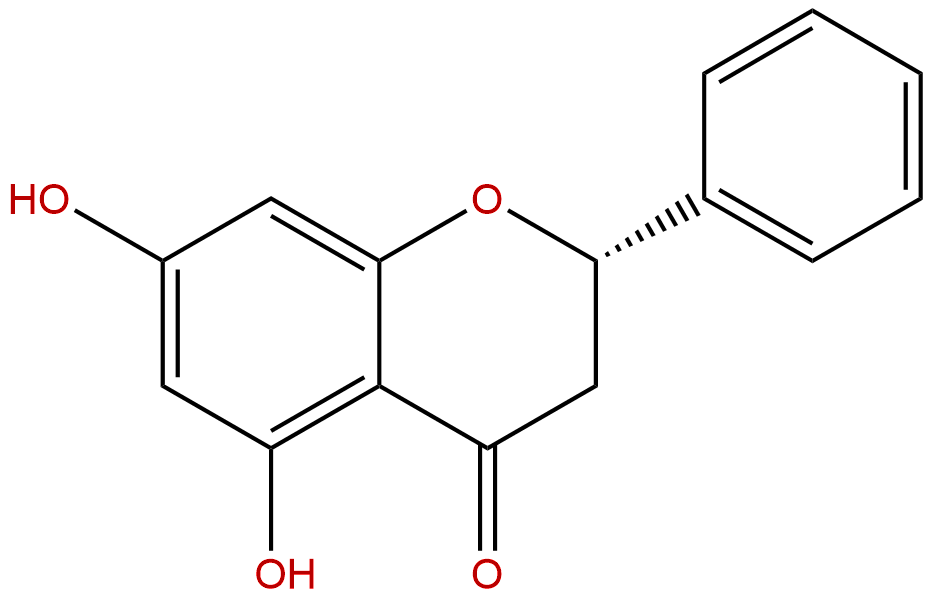
PinocembrinCAS No.:480-39-7 |
||||||||||
 |
|
|
||||||||

| Catalogue No.: | BP1107 |
| Formula: | C15H12O4 |
| Mol Weight: | 256.257 |
| Botanical Source: | Alpinia katsumadai Hayata |
Product name: Pinocembrin
Synonym name:
Catalogue No.: BP1107
Cas No.: 480-39-7
Formula: C15H12O4
Mol Weight: 256.257
Botanical Source: Alpinia katsumadai Hayata
Physical Description:
Type of Compound: Flavonoids
Purity: 95%~99%
Analysis Method: HPLC-DAD or/and HPLC-ELSD
Identification Method: Mass, NMR
Packing: Brown vial or HDPE plastic bottle
Storage: Store in a well closed container, protected from air and light. Put into refrigerate or freeze for long term storage.
Whenever possible, you should prepare and use solutions on the same day. However, if you need to make up stock solutions in advance, we recommend that you store the solution as aliquots in tightly sealed vials at -20℃. Generally, these will be useable for up to two weeks.
The product could be supplied from milligrams to grams
Inquire for bulk scale.
Description:
Pinocembrin is a major flavonoid molecule incorporated as multifunctional in the pharmaceutical industry. Its vast range of pharmacological activities has been well researched including antimicrobial, neuroprotective, anti-inflammatory, antioxidant, and anticancer activities. Pinocembrin inhibited LPS-induced inflammatory mediators production by suppressing PI3K/Akt/NF-κB signaling pathway, it also inhibited TGF-β1-induced epithelial-mesenchymal transition (EMT) and metastasis of Y-79 cells by inactivating the αvβ3 integrin/FAK/p38α signaling pathway.
References:
Eur J Pharmacol. 2015 Jun 3;761:211-216.
Pinocembrin inhibits lipopolysaccharide-induced inflammatory mediators production in BV2 microglial cells through suppression of PI3K/Akt/NF-κB pathway.
Pinocembrin, one of the primary flavonoids from Pinus heartwood and Eucalyptus, has been reported to have anti-inflammatory and antioxidant activity.
METHODS AND RESULTS:
This study was designed to evaluate the inhibitory effects of Pinocembrin on inflammatory mediators production in LPS-stimulated BV2 microglial cells. The results showed that Pinocembrin dose-dependently inhibited LPS-induced inflammatory mediators TNF-α, IL-1β, NO and PGE2 production. Pinocembrin also inhibited LPS-induced iNOS and COX-2 expression. Moreover, Pinocembrininhibited LPS-induced PI3K, Akt phosphorylation, and NF-κB activation, which were required for inflammatory mediators production. Furthermore, treatment of Pinocembrin induced nuclear translocation of Nrf2 and expression of HO-1.
CONCLUSIONS:
In conclusion, our data indicated that Pinocembrin inhibited LPS-induced inflammatory mediators production by suppressing PI3K/Akt/NF-κB signaling pathway.
Phytopathology, 1982, 72(7):877-80.
Pinocembrin: An antifungal compound secreted by leaf glands of eastern cottonwood.
Pinocembrin: An antifungal compound secreted by leaf glands of eastern cottonwood
harmacol Rep. 2015 Feb;67(1):115-22.
Pinocembrin attenuates hippocampal inflammation, oxidative perturbations and apoptosis in a rat model of global cerebral ischemia reperfusion.
Pinocembrin is a major flavonoid molecule isolated from honey and propolis. It has versatile pharmacological and biological activities including antimicrobial, anti-inflammatory, antioxidant, and anticancer activities as well as neuroprotective effects against cerebral ischemic injury. The purpose of the current study was to determine the possible mechanisms of neuroprotection elicited by Pinocembrin with specific emphasis on chronic prophylactic use before the induction of global cerebral ischemia reperfusion.
METHODS AND RESULTS:
Global cerebral ischemia-reperfusion (I/R) was induced by bilateral carotid artery occlusion for 15min followed by 60min reperfusion period. Animals were randomly allocated into 3 groups (n=28): Sham operated, I/R control and rats treated with Pinocembrin (10mg/kg, po) daily for 7 days then I/R was induced 1h after the last dose of Pinocembrin. After reperfusion rats were killed by decapitation, brains were removed and both hippocampi separated and the following biochemical parameters were estimated; lactate dehydrogenase activity, oxidative stress markers (lipid peroxides, nitric oxide and reduced glutathione), inflammatory markers (myeloperoxidase, tumor necrosis factor-alpha, nuclear factor kappa-B, interleukin-6 and interleukin-10), apoptotic biomarkers (caspase 3 and cytochrome C), neurotransmitters (glutamate, gamma aminobutyric acid) and infarct size were assessed. Pinocembrin ameliorated damage induced by I/R through suppressing oxidative stress, inflammatory and apoptotic markers as well as mitigating glutamate and lactate dehydrogenase activity. One of the more significant findings to emerge from this study is that Pinocembrin normalized the infarct size elevated by I/R.
CONCLUSIONS:
Pinocembrin showed a neuroprotective effects through antioxidant, anti-inflammatory and antiapoptotic mechanisms.
Molecules. 2014 Sep 30;19(10):15786-98.
Pinocembrin protects the brain against ischemia-reperfusion injury and reverses the autophagy dysfunction in the penumbra area.
The aim of this study was to investigate the effects of Pinocembrin on brain ischemia/reperfusion (I/R) injury and the potential involvement of autophagy activity changes in the penumbra area in the mechanisms of Pinocembrin activity.
METHODS AND RESULTS:
Focal cerebral I/R model was induced by middle cerebral artery occlusion (MCAO) for 2 h followed by 24 h reperfusion. Pinocembrin was administered intravenously at different doses (1, 3, and 10 mg/kg, respectively) at the onset of reperfusion. Neurological function, brain infarction and brain swelling ratio were evaluated. Terminal deoxynucleotidyl transferase-mediated dUTP nick end labeling (TUNEL) method and immunohistochemical analysis (Caspase-3) were used to evaluate apoptosis in the penumbra cortex. Two key proteins of autophagy, LC3B and Beclin1, were detected by western blot. The results showed that Pinocembrin-treatment could significantly reduce neurological deficit scores, infarct volume, cerebral edema and improve pathological lesion in the I/R rats. Pinocembrin-treatment could also reduce the number of TUNEL-positive and Caspase-3-positive neurons, and upregulate the expression of LC3B and Beclin1 in penumbra area.
CONCLUSIONS:
These results suggested that Pinocembrin could protect the brain against I/R injury, and the possible mechanisms might be attributed to inhibition of apoptosis and reversed autophagy activity in penumbra area.